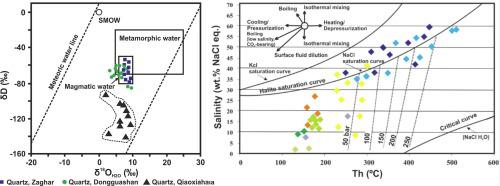当前位置:
X-MOL 学术
›
Ore Geol. Rev.
›
论文详情
Our official English website, www.x-mol.net, welcomes your
feedback! (Note: you will need to create a separate account there.)
Geology, mineralization, fluid inclusion, and stable isotope characteristics of the Zaghar and Sarabadan Cu-(Au) skarn deposits, Tafresh, Central Iran
Ore Geology Reviews ( IF 3.2 ) Pub Date : 2020-09-01 , DOI: 10.1016/j.oregeorev.2020.103646 Akram Shahhosseini , Masood Alipour-Asll , Leila Hosseina , Khalil Bahar-Firouzi
Ore Geology Reviews ( IF 3.2 ) Pub Date : 2020-09-01 , DOI: 10.1016/j.oregeorev.2020.103646 Akram Shahhosseini , Masood Alipour-Asll , Leila Hosseina , Khalil Bahar-Firouzi

|
Abstract The Zaghar and Sarabadan copper-(gold) deposits are located in the northern part of the Urumieh-Dokhtar magmatic belt. Mineralization occurred in contact of the post-Eocene diorite-tonalite stocks with the upper Triassic-Jurassic shale and sandstone series in the Zaghar, and lower Eocene volcanic and pyroclastic rocks in the Sarabadan. Based on field observation and mineralogical studies, three stages of mineralization can be distinguished: (1) prograde skarn; (2) retrograde skarn; and (3) supergene stages. The prograde skarn is characterized by association of andradite, diopside, cordierite, and minor actinolite. The retrograde skarn stage is divided into two sub-stages: (1) retrograde skarn I; and retrograde skarn II. The retrograde skarn I, is marked by deposition of the main alteration minerals (e.g., tremolite, actinolite, chlorite, epidote), magnetite, ilmenite, pyrrhotite, pyrite, barite, and small amount of other sulfide minerals. The retrograde skarn II or quartz-sulfide-carbonate stage, is characterized by quartz and calcite vein-veinlets associated with Cu-Au mineralization. The supergene stage is marked by Fe oxy-hydroxides, covellite, malachite, azurite, and minor clay minerals and calcite. Ore-forming fluids associated with the quartz, calcite, and sphalerite from the retrograde II stage of mineralization is represented by LVS fluid inclusions with the temperature of 218 to 512 ⁰C and salinity of 6.73 to 59.09 wt.% NaCl, and LV type fluids with the temperature of 130 to 215 ⁰C and salinity of 1.70 to 30.00 wt.% NaCl equivalent. Stable isotope analysis of quartz yielded values of -85.30 to -60.70 δD‰, and +7.82 to 9.60‰ δ18Ofluid, indicating that the ore-forming fluids were mainly magmatic fluids with some contributions from meteoric waters. The δ34S values of pyrite vary from +4.90 to 8.10‰, demonstrate that the sulfur in deposit was probably originated from the magma. The geological and geochemical features introduce the Zaghar and Sarabadan as Cu-(Au) skarn deposits are related to the magmatic-hydrothermal activity of diorite stocks within continental magmatic arc.
中文翻译:

伊朗中部 Tafresh 的 Zaghar 和 Sarabadan Cu-(Au) 矽卡岩矿床的地质、矿化、流体包裹体和稳定同位素特征
摘要 Zaghar和Sarabadan铜(金)矿床位于Urumieh-Dokhtar岩浆带北部。成矿发生在后始新世闪长岩-辉长岩储量与 Zaghar 的上三叠统-侏罗纪页岩和砂岩系列以及 Sarabadan 的下始新世火山和火山碎屑岩接触。根据野外观察和矿物学研究,可以将成矿分为三个阶段:(1)顺行矽卡岩;(2)逆行矽卡岩;(3) 超基因阶段。顺产矽卡岩的特点是结合了红霞石、透辉石、堇青石和次要阳起石。逆行矽卡岩阶段分为两个亚阶段:(1)逆行矽卡岩Ⅰ;和逆行矽卡岩 II。逆行矽卡岩 I 以主要蚀变矿物(如透闪石、阳起石、绿泥石、绿帘石)、磁铁矿、钛铁矿、磁黄铁矿、黄铁矿、重晶石和少量其他硫化物矿物。逆行矽卡岩 II 或石英-硫化物-碳酸盐阶段,以与 Cu-Au 矿化相关的石英和方解石脉-脉为特征。表生阶段的标志是铁羟基氧化物、钴蓝石、孔雀石、蓝铜矿和少量粘土矿物和方解石。与逆行Ⅱ期成矿石英、方解石、闪锌矿伴生的成矿流体以温度为218~512⁰C、盐度为6.73~59.09wt.%NaCl的LVS流体包裹体为代表,LV型流体为温度为 130 至 215 ⁰C,盐度为 1.70 至 30.00 wt.% NaCl 当量。石英的稳定同位素分析得出 -85.30 至 -60.70 δD‰ 和 +7.82 至 9.60‰ δ18Ofluid,表明成矿流体主要是岩浆流体,也有一些来自大气水的贡献。黄铁矿的δ34S值在+4.90~8.10‰之间变化,说明矿床中的硫可能来源于岩浆。地质和地球化学特征介绍了 Zaghar 和 Sarabadan,因为 Cu-(Au) 矽卡岩矿床与大陆岩浆弧内闪长岩储量的岩浆-热液活动有关。
更新日期:2020-09-01
中文翻译:

伊朗中部 Tafresh 的 Zaghar 和 Sarabadan Cu-(Au) 矽卡岩矿床的地质、矿化、流体包裹体和稳定同位素特征
摘要 Zaghar和Sarabadan铜(金)矿床位于Urumieh-Dokhtar岩浆带北部。成矿发生在后始新世闪长岩-辉长岩储量与 Zaghar 的上三叠统-侏罗纪页岩和砂岩系列以及 Sarabadan 的下始新世火山和火山碎屑岩接触。根据野外观察和矿物学研究,可以将成矿分为三个阶段:(1)顺行矽卡岩;(2)逆行矽卡岩;(3) 超基因阶段。顺产矽卡岩的特点是结合了红霞石、透辉石、堇青石和次要阳起石。逆行矽卡岩阶段分为两个亚阶段:(1)逆行矽卡岩Ⅰ;和逆行矽卡岩 II。逆行矽卡岩 I 以主要蚀变矿物(如透闪石、阳起石、绿泥石、绿帘石)、磁铁矿、钛铁矿、磁黄铁矿、黄铁矿、重晶石和少量其他硫化物矿物。逆行矽卡岩 II 或石英-硫化物-碳酸盐阶段,以与 Cu-Au 矿化相关的石英和方解石脉-脉为特征。表生阶段的标志是铁羟基氧化物、钴蓝石、孔雀石、蓝铜矿和少量粘土矿物和方解石。与逆行Ⅱ期成矿石英、方解石、闪锌矿伴生的成矿流体以温度为218~512⁰C、盐度为6.73~59.09wt.%NaCl的LVS流体包裹体为代表,LV型流体为温度为 130 至 215 ⁰C,盐度为 1.70 至 30.00 wt.% NaCl 当量。石英的稳定同位素分析得出 -85.30 至 -60.70 δD‰ 和 +7.82 至 9.60‰ δ18Ofluid,表明成矿流体主要是岩浆流体,也有一些来自大气水的贡献。黄铁矿的δ34S值在+4.90~8.10‰之间变化,说明矿床中的硫可能来源于岩浆。地质和地球化学特征介绍了 Zaghar 和 Sarabadan,因为 Cu-(Au) 矽卡岩矿床与大陆岩浆弧内闪长岩储量的岩浆-热液活动有关。











































 京公网安备 11010802027423号
京公网安备 11010802027423号